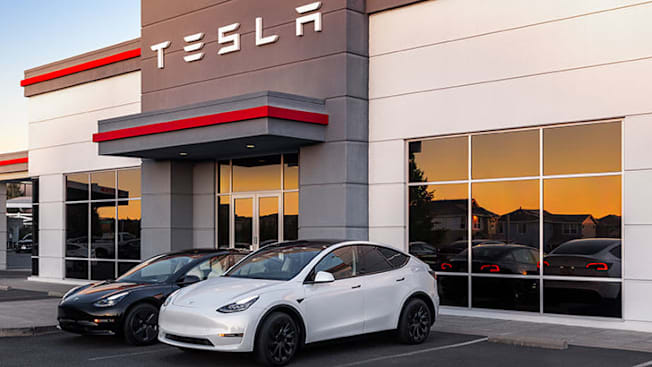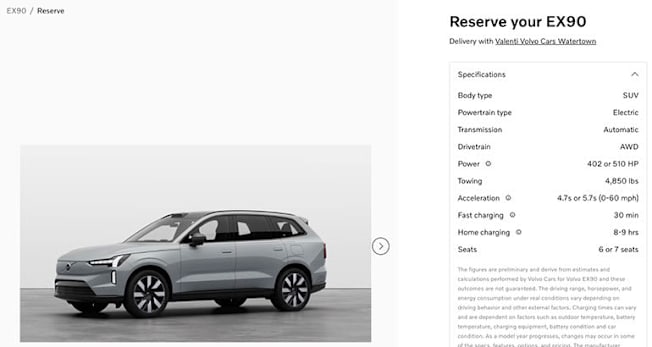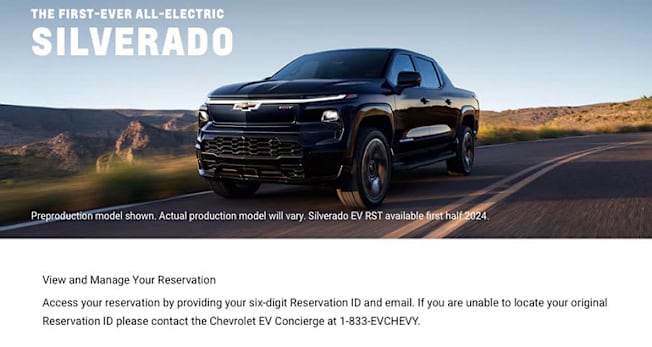Online car shopping can eliminate traditional hassles, but in CR’s experience, it can also create new ones—especially if you’re buying from a startup

By Keith Barry
When Tesla first started selling its Model S EV online in 2012, buying a new car over the internet was unheard of. Since then, a slew of new automakers, including Fisker, Lucid, Rivian, and VinFast, have followed in the footsteps of Tesla’s online sales model. Today, consumers have gotten used to the idea of purchasing an expensive vehicle—sight unseen—on a manufacturer’s website, eliminating the need to haggle with a salesperson.
Even legacy automakers with large dealer networks, like Honda, Ford, and Volvo, allow you to configure and reserve your new car online for certain new, buzz-worthy models.
Consumer Reports buys every car we test, and our team has had mixed experiences with the dozen or so cars we’ve bought online—including our Fisker Ocean.
While online ordering can be a real convenience, we’ve sometimes encountered minor hiccups that turned into bigger headaches—especially when a manufacturer is new to building cars.
To help you avoid unpleasant surprises, here’s what you need to know if you’re considering ordering a car online.

Volvo’s webpage lets you reserve an EX90 SUV from a local dealership.
Photo: Volvo
The Buying Process
If a vehicle model is brand new to the market, such as the Rivian R2 or Volvo EX90, you’ll probably start your purchase process by downloading an app or going to the automaker’s website. There, you’ll be treated to a lot of information extolling the virtues of the new model and be invited to make a small deposit—usually between $100 and $500—to reserve your car. The deposit is usually refundable and helps the automaker gauge consumer interest in the vehicle.
When the manufacturer is ready to build the vehicle—which, in our experience, has been anywhere from a few months to more than a year after the reservation process opens—a representative will reach out to ask whether you want to convert that reservation into an actual order. That’s when you’ll select options and find out the total price.
If the car is already in production, you’ll skip the reservation part and head straight to selecting options. In both cases, there’s no opportunity to negotiate the price and you probably won’t have a chance to test-drive the car, although some automakers will let you return a new vehicle after a few days if you don’t like it.
“On the one hand, you buy the car from the comfort of your couch, you do everything online, and the price is non-negotiable, so there’s none of that whole dealership nightmare that everybody is always dreading,” says Gabe Shenhar, associate director of CR’s auto test center, who has personally purchased several cars online on behalf of CR. “But you sometimes hear nothing for months on end until all of a sudden you get an email that your reservation has turned into an order, and then you get an email that your car is ready,” says Shenhar.

Once you’ve made a reservation, it might be a while before you can pick up your new vehicle.
Photo: Chevrolet
The sales process can vary, depending on where you live and what kind of car you’re buying. Some states—including Connecticut, where CR’s auto test center is based—have laws prohibiting automakers from selling cars directly to individuals, and some automakers already have existing dealer networks. In those cases, you’ll either be put in touch with a local dealership or have to travel out of state to pick up your vehicle.
Dealerships can sometimes add a markup to the price listed online, or otherwise obfuscate the process. Alex Knizek, associate director of auto test development at CR, had some issues ordering a car from Acura.
“When it came time for the actual dealership to get involved, it was like I’d never done the reservation,” he says. “I spent all this time picking out the spec of the car, putting a deposit down, and it felt like the dealer never got any of that information other than my name, and I had to do it all again.” However, the CR staffer who purchased our Honda Prologue (Honda is Acura’s parent company) reported that it was a smooth experience.
Startup automakers may not have started building cars yet, and in some cases they may not have even built a factory. The company itself may struggle, as is the case with Fisker, which announced an indefinite pause in manufacturing before declaring bankruptcy.
We still haven’t received our Tesla Cybertruck, which we put a deposit on in November 2023, and we’re still waiting for our Polestar 3, which we put a deposit on in December 2023. But even automakers with existing factories and dealers can have issues with brand-new models—we waited two years for our Cadillac Lyriq.
“That’s why we’ve always given the same advice: Don’t buy a car in its first model year,” says Knizek.
Picking Up Your New Car—Or Getting It Delivered
How you pick up your car largely depends on the automaker, says Steven Elek, who oversees automotive data analytics for CR and is a frequent buyer of CR test cars.
For example, when he picked up our Lucid at the Mall at Short Hills in Millburn, N.J., along with Mike Crossen, a mechanic at CR, they were both shocked by how simple the process was. Nobody took them to a back room and gave them a hard sales pitch for an extended warranty or VIN etching. In fact, nobody even checked their identification.
Instead, a salesperson brought them from the sleek showroom through a back hallway to an elevator up to the fifth floor of a parking garage where the car sat—an experience that felt like completing a quest in a video game, says Crossen.
“I almost expected to see a glowing arrow above the car,” he says.

CR’s Fisker Ocean was delivered to our auto test center in an enclosed trailer.
Photo: Mike Crossen/Consumer Reports
Other automakers, including Fisker and Rivian, offer at-home deliveries. Both our Rivians were delivered by professionals who gave us detailed walk-throughs of the vehicles, including iPad-based tutorials on unique features. On the other hand, the delivery contractors who dropped off our Fisker Ocean had trouble starting the vehicle and could not answer any of our questions about it.
In both cases, the people dropping off the cars couldn’t help us with delivery issues. Our Rivian R1T had a broken tonneau cover, and our Ocean was dented and missing accessories. We had to call the automakers directly to fix the problems.
“As annoying as a dealership can be, it provides a sense of legitimacy,” says Knizek. “And if there’s anything wrong on the spot, you have the ability to get it taken care of.”
Getting Your Car Repaired
Selling cars exclusively online saves new companies from building out costly dealer networks and service centers before they even have products to sell.
Many startup automakers promise that you can schedule service or repair appointments at home or work using an app or a website. In reality, it can be a little more complicated.
“When we’ve had mobile service come, half a dozen times from different startup manufacturers, they tend to be the cream of the crop in terms of the ability to repair cars,” says John Ibbotson, manager of auto testing at CR, whose responsibilities include diagnosing and arranging repairs for our fleet of test vehicles. “They usually show up in a vehicle from the same brand. They’re very top-notch and professional.”
Mobile service may be convenient for consumers, but it also cuts into the time technicians can spend making repairs, says Crossen, who predicts automakers may take away this perk in the future. “From a technician’s point of view, I would hate to be a tech who spends more time driving between cars than actually fixing cars,” he says. “It seems wildly inefficient in terms of time.”
When a mobile technician has been unable to fix a problem on one of our vehicles, they’ve typically made arrangements to get it to the closest service center—usually a central facility that’s owned by the automaker or a local shop that’s authorized to work on the car.
Consumer Reports’ test track is located about 120 miles from Manhattan and 120 miles from Boston, where many startup automakers have showrooms or service centers. If you live even farther away from a major city, it might be more difficult to get service.

A Rivian Space in Pasadena, Calif. It may look like a traditional dealership, but it doesn’t have acres of new cars awaiting purchase.
Photo: Rivian
Some Startup Automakers Are Changing Tactics
If you like online ordering and mobile service, don’t get too used to it—we’re already starting to see some newer automakers evolve past it.
When we ordered our Polestar 2 in 2021, we communicated directly with a salesperson via his personal email address. “I wondered, ‘Am I even sending this to the right place?’” says Elek. Since then, Polestar—which has the same corporate parent company as Volvo—started partnering with specific Volvo dealerships. EV startup VinFast announced that 15 dealers will sell its cars directly, and Fisker announced partnerships with dealerships before its bankruptcy announcement.
And then there’s Tesla. “Every experience we’ve had with Tesla has been different,” says Elek. The first few times we ordered a Tesla, the car was delivered directly to our test track and a specialist walked us through how to use it. Lately, when we’ve placed an order online we’ve had to pick up the car at a local delivery center, which feels a lot more like buying a car from a traditional dealership.
Our experts agree that as automakers grow, they start to outgrow the online model. “It’s not scalable, but maybe the company thinks, ‘As we get bigger, if volume picks up, we’ll figure it out as we go along,’” says Shenhar.
Pros of Buying a Car Online
- You don’t have to go through the awkwardness of haggling for a better price.
- You can buy a car from the comfort of your living room.
- For vehicles that debut with online ordering, you can be the first on your block to get the latest new model.
Cons of Buying a Car Online
- You might have to wait years for a brand-new model to become available.
- Brand-new models tend to be less reliable.
- There’s no opportunity to test-drive the car.
Consumer Reports is an independent, nonprofit organization that works side by side with consumers to create a fairer, safer, and healthier world. CR does not endorse products or services, and does not accept advertising. Copyright © 2024, Consumer Reports, Inc.









